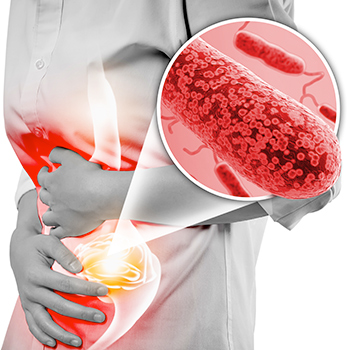
As with all families, the E. coli family of bacteria has some good, some bad and some ugly members. Mostly, you hear about the worst of the worst, E. coli O157:H7. When you hear about an E. coli outbreak, this is typically the bad boy they are talking about.
Escherichia coli (E. coli) is a large and diverse group of bacteria that normally lives in the intestines of people and animals. Most are harmless and are actually an important part of a healthy human intestinal tract. However, other strains can cause diarrhea or illness outside of the intestinal tract. The types of E. coli that can cause diarrhea can be transmitted through contaminated water or food, or through contact with animals or people.
The pathogenic E. coli strains that can make you sick are categorized into pathotypes. Six pathotypes are associated with diarrhea and are collectively referred to as diarrheagenic E. coli.
- Shiga toxin-producing E. coli (STEC)—STEC may also be referred to as Verocytotoxin-producing E. coli(VTEC) or enterohemorrhagic E. coli (EHEC)
- Enterotoxigenic E. coli (ETEC)
- Enteropathogenic E. coli (EPEC)
- Enteroaggregative E. coli (EAEC)
- Enteroinvasive E. coli (EIEC)
- Diffusely adherent E. coli (DAEC)
“Shiga Toxin-Producing” E. coli
Some kinds of E. coli cause disease by making a toxin called Shiga toxin. The bacteria that make these toxins are called “Shiga toxin-producing” E. coli, or STEC for short. You might hear these bacteria called verocytotoxic E. coli (VTEC) or enterohemorrhagic E. coli (EHEC). These all refer generally to the same group of bacteria. The most commonly identified STEC in North America is E. coli O157:H7. Some types of STEC frequently cause severe disease, including bloody diarrhea and hemolytic uremic syndrome (HUS), which is a type of kidney failure.
In addition to E. coli O157, many other kinds (called serogroups) of STEC cause disease. Other E. coliserogroups in the STEC group, including E. coli O145, are sometimes called non-O157 STECs. Currently, there are limited public health surveillance data on the occurrence of non-O157 STECs, including STEC O145. Many STEC O145 infections may go undiagnosed or unreported. Other non-O157 STEC serogroups that often cause illness in people in the United States include O26, O111, and O103. The USDA is cracking down on more STECs than the O157 strain.
Symptoms of E. coli Infection
The symptoms of STECs vary from person to person but usually include severe stomach cramps, bloody diarrhea and vomiting. There may also be fever, nausea and other flu-like symptoms. However, these symptoms should not be confused with the flu, especially if there is bloody diarrhea. To learn how to differentiate the symptoms of food poisoning from those of other illnesses, read “Food Poisoning” or Something Else? How to Tell.
The time between ingesting the STEC bacteria and experiencing the symptoms is usually 3-4 days, but may be as short as a day or as long as 10 days. About 5-10% of people infected by a STEC develop the potentially life-threatening condition hemolytic uremic syndrome (HUS). HUS, if it occurs, develops about 7 days after the first symptoms, when the diarrhea is improving. Persons with HUS should be hospitalized because their kidneys may stop working and they may develop other serious problems. Most persons with HUS recover within a few weeks, but some suffer permanent damage or die.
Preventing E. coli Exposure
There are things you can do to help reduce your exposure to E. coli. Here’s what the experts suggest:
- Wash hands thoroughly after using the bathroom and before eating.
- Vigorously scrub or wash all fruits and vegetables before eating. If not cooked, fruits and vegetables should also be soaked in chlorinated water (1 tsp. bleach in one qt. of water for 15 minutes).
- Cook ground beef to 160-degrees and check using a meat thermometer. Just because the meat is brown doesn’t mean it’s cooked enough.
- Avoid cross-contamination of foods by washing cutting boards, counter tops and utensils in hot, soapy water before and after using.
- Do not allow children to share bath water with anyone who has any signs of diarrhea or “stomach flu.” Keep toddlers still in diapers out of all bodies of water, especially wading and swimming pools.
- Wear disposable gloves when changing the diapers of any child with any type of diarrhea. If gloves are not available, wash hands with hot, soapy water for at least 20 seconds.
- Avoid drinking any non-chlorinated water. There is an added risk if the water is near or downstream from livestock.
RELATED POSTS
Food Poisoning” or Something Else? How to Tell
Listeria: A Rare but Deadly Bug
Salmonella. You’ve Heard of It, Now Learn About It
